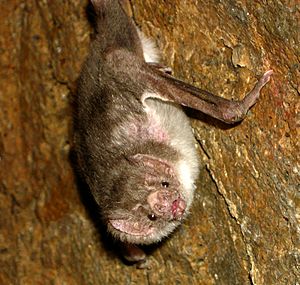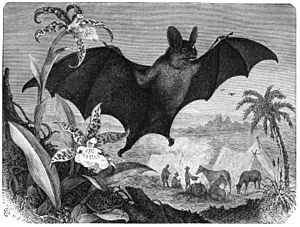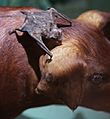Vampire bat facts for kids
Quick facts for kids Vampire bat |
|
|---|---|
 |
|
| Common vampire bat (Desmodus rotundus) | |
| Scientific classification |
|
| Kingdom: | Animalia |
| Phylum: | Chordata |
| Class: | Mammalia |
| Order: | Chiroptera |
| Family: | Phyllostomidae |
| Subfamily: | Desmodontinae Bonaparte, 1845 |
| Genera | |
Vampire bats are a special group of bats. What makes them unique is that they are the only bats that feed on blood. There are three known types, or species, of vampire bats. One species drinks the blood of mammals, while the other two prefer the blood of birds.
The common vampire bat lives in big groups, sometimes with as many as 100 bats! They have amazing ways of living together and helping each other. For example, if one bat doesn't find food, another bat might share some of its blood meal with it.
Vampire bats can sometimes spread diseases, like rabies. However, their saliva is also very interesting to scientists. It contains special chemicals that stop blood from clotting, which means it stays liquid. Scientists have studied these chemicals to help create medicines for people who have had strokes or heart attacks.
It's important to know that "false vampire bats" are not true vampire bats. They do not drink blood. Instead, some false vampire bats eat fruits, and others hunt small animals.
Some people believe that the idea of Vampires in stories might have come from observing these unique bats.
Where Do Vampire Bats Live?
Vampire bats usually live in large groups called colonies. They like places that are almost completely dark, such as caves, old wells, hollow trees, and even abandoned buildings. All vampire bats live in North, Central, and South America, in countries like Mexico, Brazil, Chile, and Argentina. They can be found in areas that range from very dry to very wet, and in both tropical and subtropical climates. A vampire bat colony can have just a few bats or hundreds living together in their roosting spots.
How Scientists Study Vampire Bats
Vampire bats were among the first animals to be studied using a cool new tool called the Broadly Applicable Tracking System, or BATS. Scientists carefully attached tiny backpacks with sensors to the bats. These backpacks used GPS technology to track where the bats went. This helped scientists learn when the bats were looking for food, resting, or meeting up with other bats.
A study published on October 31, 2019 (which is Halloween!), showed something really interesting. It found that vampire bats formed friendships and social connections even when they were being held by humans. The bats remembered these bonds after they were released back into the wild. This shows how smart and social these creatures are!
Images for kids
-
A common vampire bat at the Louisville Zoo
See also
 In Spanish: Murciélagos vampiro para niños
In Spanish: Murciélagos vampiro para niños





